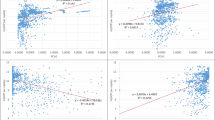Abstract
The outbreak of war is generally thought to shift the fields in which research is conducted. As a result, military conflict has historically been credited with being the catalyst which has caused decisive technological advances. It is also generally suggested that warfare has a systematic impact on the intensity of inventive activity. Most scholars have claimed that wars increase inventiveness, although a few argue that conflict is a hinderance to research. This question has not received extensive empirical examination. Using United States data, we show that a basic pattern is repeatedly observed. Immediately after the outbreak of a war, there is a significant decline in inventiveness, which is followed by a marked surge. The average net result is a virtual negation of the two trends.
Similar content being viewed by others
Notes and References
G. DANIELS, The Big Questions in the History of American Technology,Technology and Change 11 (1970), 1–21.
See, for example, L. LAVE,Technological Change: Its Conception and Measurement, Englewood Cliffs, 1966, p. 72.
N. REINGOLD, US Patent Office Records as Sources for the History of Invention and Technological Property,Technology and Culture 1 (1959), 156–167.
See, for example, J. E. S. PARKER,The Economics of Innovation, London, 1974, p. 27–28; S. C. GILFILLAN, An Attempt to Measure the Rise of American Inventing and the Decline of Patenting,Technology and Culture 1 (1959), 204.
W. COMANOR and F. M. SCHERER, Patent Statistics as a Measure of Technical Change,Journal of Political Economy 77 (1969), 392–398.
J. E. S. PARKER,The Economics of Innovation, London, 1974, p. 27.
R. POST, ‘Liberalizers’, Versus ‘Scientific Men’ in the Antebellum Patent Office,Technology and Culture 17 (1976), 24–54.
R. POST, —, 24.
A. STAFFORD, Is the Rate of Invention Declining?American Journal of Sociology 57 (1953), 539–545; GILFILLAM (1959).
See D. K. SIMONTON, Techno-Scientific Activity and War: A Yearly Time Series Analysis, 1500–1903 A. D.,Scientometrics 2 (1980), 251–255.
See J. SCHMOOKLER, An Economist Takes Issue,Technology and Culture 1 (1959), 214–220, who comes to this conclusion.
C. SMITH, Science and Practice in the History of Metallurgy,Technology and Culture 2 (1961), 366.
A. KRAMMER, Fueling the Third Reich,Technology and Culture 19 (1978), 394–422.
B. HACKER, The Weapons of the West,Technology and Culture 18 (1977), 43.
J. PERKINS, Reshaping Technology in Wartime: The Effect of Military Goals on Entomological Research in Insect-Control Practices,Technology and Culture 19 (1978), 169–186.
W. Kaempffert,Science and Technology: Offspring of War, (New York, 1942).
W. Kaempffert,Science and Technology: Offspring of War, (New York, 1942), p. 19.
L. MUMFORD, History: Neglected Clue to Technological Change,Technology and Culture 3 (1962), 234.
A. STAFFORD, —, 541.
DANIELS, 7.
STANLEY L. ENGERMAN, The Economic Impact of the Civil War,Explorations in Entrepreneurial History, Series 2, Vol. 3 (1966), 192. Since ENGERMAN wrote, there have been few empirical studies, which have uniformly found only weak relationships. They include SIMONTON (1980); R. NAROLL, E. C. BENJAMIN, F. K. FOHL, M. J. FRIED, R. E. HIDRETH, J. M. SCHAEFFER, Creativity: A Cross Historical Pilot Survey,Journal of Cross-Cultural Psycholgy 2 (1971), 181–188; D. K. SIMONTON, The Causal Relation between War and Scientific Discovery: An Exploratory Cross-National Analysis,Journal of Cross-Cultural Psychology 7 (1976) 133–144.
For more detail on estimating such equations see Michael LEWIS-BECK, Some Economic Effects of Revolutions: Models, Measurement, and the Cuban Evidence,American Journal of Sociology 84 (1979), 1127–1149.
B. CASTRO, The Scientific Opportunities Foregone because of More Readily Available Federal Support for Research in Experimental than Theoretical Physics,Journal of Political Economy 76 (1968), 601–614.
Author information
Authors and Affiliations
Rights and permissions
About this article
Cite this article
Brunk, G.G., Jason, G.J. The impact of warfare on the rate of invention: A time series analysis of United States patent activity. Scientometrics 3, 437–455 (1981). https://doi.org/10.1007/BF02017436
Received:
Revised:
Issue Date:
DOI: https://doi.org/10.1007/BF02017436




